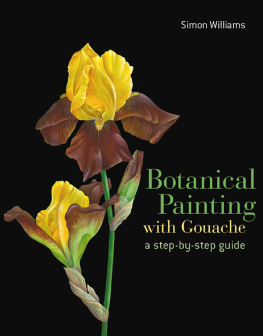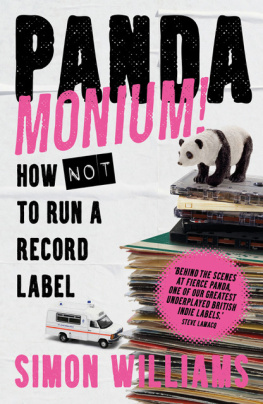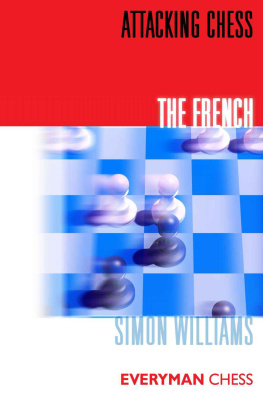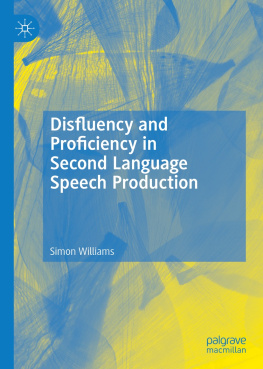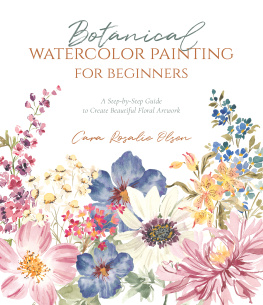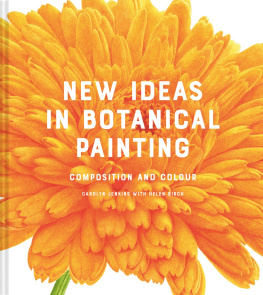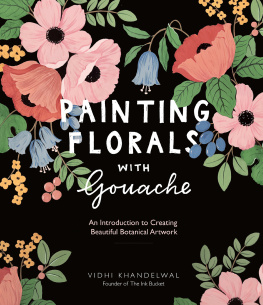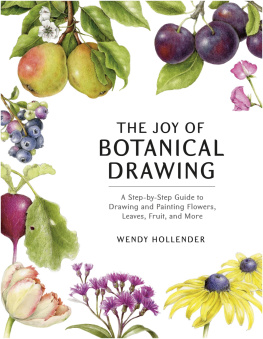BOTANICAL
PAINTING
WITH GOUACHE
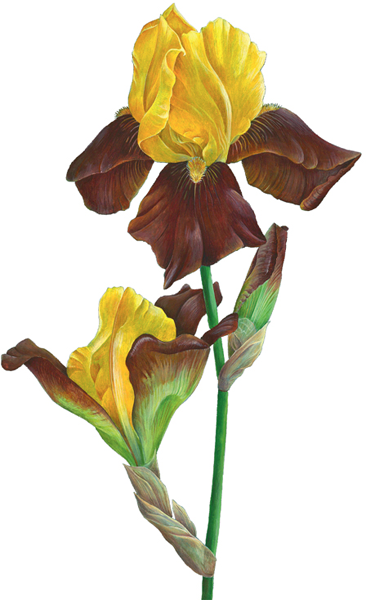
BOTANICAL
PAINTING
WITH GOUACHE
Simon Williams

Contents
Foreword
I have known Simon since 2001, when he first submitted paintings for the London exhibition of the Society of Botanical Artists. When these appeared before the selection committee we were highly impressed by the quality of the work offered by this 21-year-old, fresh from art college. When equally stunning paintings appeared the following year we had no hesitation in offering him full membership of the Society and on acceptance he became our youngest-ever member.
Over the years I have watched Simon grow in stature both as an artist and a man. His work has never ceased to delight and he has proved to be an exceptional tutor, not only passing on his knowledge in the rendition of botanical subjects but also other aspects of the natural world ranging from insects to birds and fish. It is fitting that he has already made three trips overseas in pursuit of his art, working in the style of those intrepid artists who accompanied explorers in days gone by and proving that it is still possible to get off the beaten track and leave the studio behind.
For his most recent trip a bursary was made available to him, thanks to Ling Design and the SBA. His use of gouache as the medium of choice, coupled with the modern acrylic gouache, builds on the tradition of centuries of painters before English transparent true watercolour became fashionable. Gouache, or body colour, is closely related to tempera and has been in use since the days of ancient Egypt, remaining in fashion in mainland Europe throughout the 20th century. Now there is a resurgence of interest as the medium is seen to provide rich colour perfect for capturing exotic flowers and for commercial, illustrative work where it has never ceased to be the most popular medium. I believe this book will be of immense value for those seeking to learn more about painting with gouache and no one will fail to take pleasure in Simons stunning artwork.
Margaret Stevens PSBA 2013
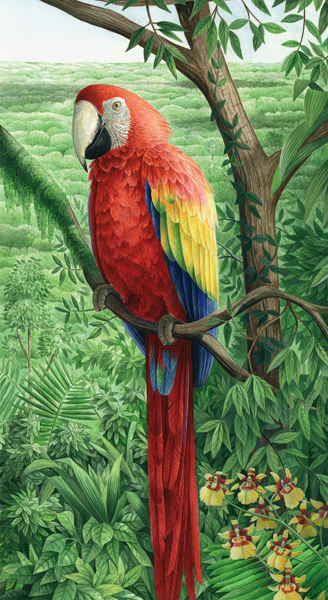
Rainforest Gouache on paper 38 x 20cm (15 x 8in) This picture of a scarlet macaw (Ara macao) and an Oncidium orchid was done to combine both botanical and natural-history illustration. Gouache captured the vivid reds of the macaw and the array of green foliage with rich intense colours while retaining a serenity in the composition.
Introduction
As an artist who prefers to work in gouache, I have long recommended the use of this medium. In recent years it has fallen out of fashion in some quarters, being considered in some way inferior to pure watercolour. This is unfortunate, for when I speak with artists of an earlier generation it is apparent that no such distinction used to be made certainly not in Continental Europe where gouache originated, as its French name implies.

Cymbidium
African Adventure Sahara Gold
Gouache over acrylic on mountboard
56 x 44cm (22 x 17in)
This orchid was my first to paint on a coloured support. The original drawing was very precise and the acrylic white underpainting had to be carefully done as there are a lot of overlapping petals that can easily get confused if observations are not spot on.

Phalaenopsis grandiflora
Gouache over acrylic on mountboard
56 x 44cm (22 x 17in)
Working with white gouache is not an easy task with artwork this size because it can build up very opaquely and look chalky if not applied with meticulous care and attention. Here in some areas there are up to ten thin layers of Permanent White gouache applied to give the brightest white.

Variegated Monstera deliciosa
Turner Acryl gouache on illustration board
76 x 56cm (30 x 22in)
Gouache, or body colour, pre-dates the Renaissance, and can be found in work across the centuries from illuminated manuscripts to artists such as Turner, the Pre-Raphaelites, Henri Matisse, Graham Sutherland, Andy Warhol and now Anish Kapoor, the darling of the contemporary art world. It is made similarly to watercolour but in addition to gum arabic other agents are used to render it opaque and reflective. Thicker than watercolour, it sits on the surface of the paper rather than being absorbed by it in the manner of watercolour. In its application one can work from dark to light in the same way as painting in oils.
Many botanical artists and flower painters found gouache the perfect medium to show off the brilliance of blooms, among them Hercules Brabazon, whose delightfully free but realistic vase of full-blown roses, painted around 1887 and now in the Tate Gallery in London, shows how the medium is the equal of both oil and transparent watercolour. Those botanical artists from the past whom we most admire, such as the Bauer brothers, Ferdinand and Franz, were taught to mix their own paints since they did not have the luxury of buying ready-prepared tubes and pans. Their methods are well documented and clearly they were making gouache with a white base. Johann Christian Jacob Friedrich, a botanical illustrator from Dresden and contemporary of the Bauers, left very specific written instructions for the preparation of both paper and pigment including the following: when you are building up a body of colour that is when you mix another colour with white you must apply another colour which has not been mixed with white first. Good sound advice and the reason students are advised to keep the white pigment well away from the other colours on the palette so that they are not unduly corrupted.
When one considers how labour-intensive the preparation of paint and the priming of paper was, it is truly amazing that artists such as the Bauers managed to turn out such a huge body of work. It must also be the case that their working days were shorter, for in the late eighteenth and early nineteenth centuries poor light would have brought painting to an early halt during the winter months.
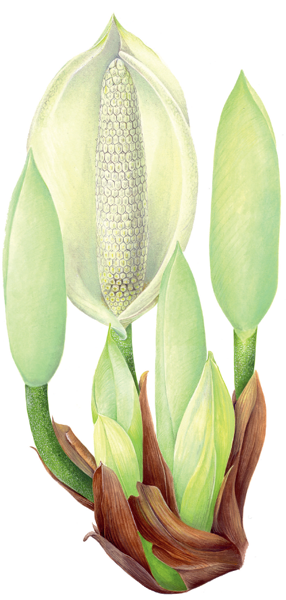
Monstera Flower
Turner Acryl gouache on Fabriano Artistico watercolour paper
48 x 35cm (19 x 13in)
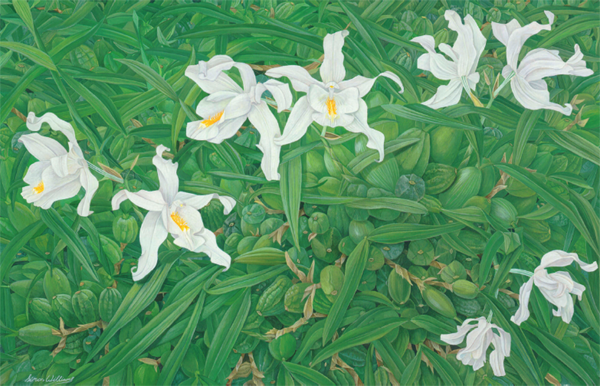
Coelogyne cristata
Gouache on paper
25 x 40cm (10 x 15in)
This painting took two years to complete. There was only one flower on the plant at the time of drawing so I spent many months working on the leaves and pseudo bulbs, waiting until the following year to paint in the rest of the flowers.
Eventually pans and tubes of paint became readily available, but it was the 1930s before designers gouache as we know it today came on the market. This contains a white filler in addition to gum arabic, whereas the more expensive artists quality range relies on more pigment to create the opacity and leaves it to the artist to add the white as desired.
Next page
